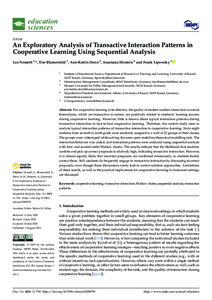| dc.date.accessioned | 2023-11-22T14:29:58Z | |
| dc.date.available | 2023-11-22T14:29:58Z | |
| dc.date.issued | 2023-08-03 | |
| dc.identifier | doi:10.17170/kobra-202311229059 | |
| dc.identifier.uri | http://hdl.handle.net/123456789/15205 | |
| dc.description.sponsorship | Gefördert durch den Publikationsfonds der Universität Kassel | ger |
| dc.language.iso | eng | |
| dc.rights | Namensnennung 4.0 International | * |
| dc.rights.uri | http://creativecommons.org/licenses/by/4.0/ | * |
| dc.subject | cooperative learning | eng |
| dc.subject | transactive interaction | eng |
| dc.subject | Markov chains | eng |
| dc.subject | sequential analysis | eng |
| dc.subject | interaction patterns | eng |
| dc.subject.ddc | 370 | |
| dc.title | An Exploratory Analysis of Transactive Interaction Patterns in Cooperative Learning Using Sequential Analysis | eng |
| dc.type | Aufsatz | |
| dcterms.abstract | For cooperative learning to be effective, the quality of student–student interaction is crucial. Interactions, which are transactive in nature, are positively related to students’ learning success during cooperative learning. However, little is known about typical interaction patterns during transactive interaction in face-to-face cooperative learning. Therefore, the current study aims to analyze typical interaction patterns of transactive interaction in cooperative learning. Sixty-eight students from seventh to tenth grade were randomly assigned to a total of 23 groups in their classes. The groups were videotaped while solving the same open-ended mathematical modelling task. The interaction behavior was coded, and interaction patterns were analyzed using sequential analysis with first- and second-order Markov chains. The results indicate that the likelihood that students confirm and pick up correct proposals is relatively high, indicating transactive interaction. However, it is almost equally likely that incorrect proposals are confirmed erroneously, as students barely correct them. Still, students do frequently engage in transactive interaction by discussing incorrect proposals, even though these discussions rarely lead to correct solution approaches. Limitations of these results, as well as the practical implications for cooperative learning in classroom settings, are discussed. | eng |
| dcterms.accessRights | open access | |
| dcterms.creator | Nemeth, Lea | |
| dcterms.creator | Blumenfeld, Tim | |
| dcterms.creator | Denn, Ann-Katrin | |
| dcterms.creator | Hirstein, Anastasia | |
| dcterms.creator | Lipowsky, Frank | |
| dcterms.extent | 20 Seiten | |
| dc.relation.doi | doi:10.3390/educsci13080790 | |
| dc.subject.swd | Markov-Modell | ger |
| dc.subject.swd | Kooperatives Lernen | ger |
| dc.subject.swd | Verhaltensmuster | ger |
| dc.subject.swd | Sequentialanalyse | ger |
| dc.type.version | publishedVersion | |
| dcterms.source.identifier | eissn:2227-7102 | |
| dcterms.source.issue | Issue 8 | |
| dcterms.source.journal | Education Sciences | eng |
| dcterms.source.volume | Volume 13 | |
| kup.iskup | false | |
| dcterms.source.articlenumber | 790 | |
| ubks.epflicht | true | |


